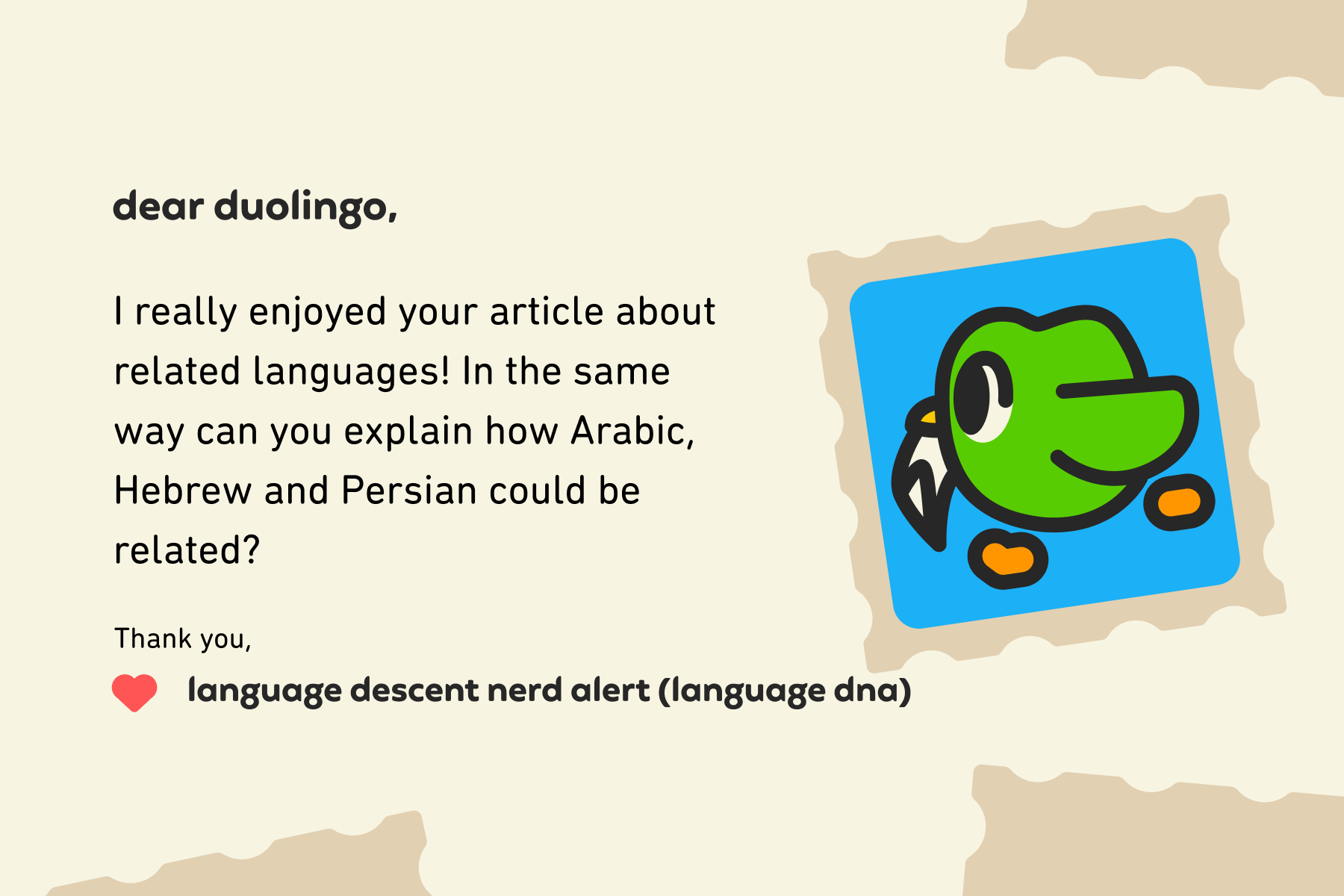Welcome to another week of Dear Duolingo, an advice column just for learners. Catch up on past installments here.
Hi, learners! I'm Dr. Emilie Zuniga, and this is my first week taking over the Dear Duolingo column—but you might have read my posts about being a hyperpolyglot and cultural influences on languages (like why "left" is a taboo word in some languages). This week's question combines these interests!
Our question this week:

What an insightful gem of a question! 🌟 You are right that Arabic, Hebrew, and Persian have some similarities, and you are also wise not to assume this is because they are related. There are a number of reasons why languages might look or sound the same, but they are only related when we can trace them back to a common ancestor. Looking at these languages' histories, we can see that Arabic and Hebrew are related, but Persian is in a different language family tree entirely!
Arabic and Hebrew are Semitic languages
Arabic and Hebrew are both part of the Semitic language family, which contains many extinct languages like Akkadian, Babylonian, and Phoenician, as well as many languages still spoken today, like Modern South Arabian, Amharic, Neo-Aramaic, and Maltese—the only Semitic language to be an official language of the European Union!
Both languages have complicated and fascinating histories. They've also been in contact with each other throughout history because of shared geographical territory: They're neighbors!
Today, Arabic has approximately 310 million native speakers (and many more who use it as a second language), it's the lingua franca of the Middle East and North Africa, and it's one of the United Nations' six official languages. Hebrew is spoken by around 9 million people worldwide. Let’s take a quick look at each:
A brief history of Arabic
Arabic's origins are in the Arabian Peninsula, where there are early Arabic writings from the 2nd century CE. As the language grew and evolved, it came into contact with other tribes and peoples (and their languages, too, of course!). From its earliest days, Arabic was used for trade, poetry and storytelling.
The revelation of the Quran in the 7th century CE, celebrated every year by Muslims worldwide during the holy month of Ramadan, granted Quranic Arabic its highly revered position within Islam. Quranic Arabic has been kept basically unchanged for the last 1400 years, and today it is used in a preserved state in Islamic education and religious practice. There's a different variety, called Modern Standard Arabic (MSA), used today for literature, education and politics, and MSA was developed less than two centuries ago as a modernized version of an older, literary form of Arabic.
The Islamic conquests that followed the revelation of the Quran spread Arabic across vast territories, from Al-Andalus in the Iberian Peninsula to Central Asia. Through this process, spoken Arabic absorbed new linguistic features from other cultures and languages, lost others, and eventually evolved into the regional dialects that are used today for everyday communication.
A brief history of Hebrew
The earliest written evidence of Paleo-Hebrew—a very early version of Hebrew—was discovered in the ancient kingdom of Judah and is from the 10th century BCE. Later, the Tanakh (referred to as the Old Testament by Christians) was composed over many centuries, up until the 2nd century BCE. Because it was written over such a long period of time, it documents some of the evolution of Hebrew into many literary forms including epic narratives, poetry, laws, and prophecies, mirroring the ancient Israelites' culture and spiritual life.
Over those centuries, Hebrew also flourished as the spoken language of the Israelites. It eventually fell out of use as a language of everyday life following several historical events, such as the destruction of the Second Temple in 70 CE by the Romans and the ensuing dispersal of Jewish communities, who progressively adopted the local languages of their new communities and developed new languages and dialects (including Yiddish, Ladino, and Judeo-Arabic). By medieval times, Hebrew was primarily a literary and religious language among Jewish scholars, rabbis, and religious groups.
Centuries later, in the late 19th and early 20th centuries, a fervent effort took root to revive Hebrew from its primarily religious uses into a true spoken language. Linguists and scholars modified Hebrew’s grammar and expanded its vocabulary by borrowing and creating new words to adapt it for the needs of modern life.
An example of Semitic grammar: word roots
Because Arabic and Hebrew are part of the same large language family, their grammars often "work" in similar ways. The exact details typically differ, but their grammar systems show similarities. An especially cool example of this—and one that is quite different from Persian—is grammatical "roots."
Most words in Arabic and Hebrew come from a root that is made up of three consonants with a core meaning. For example, the root K-T-B is for words related to writing (sometimes in Hebrew K is pronounced as KH and B as V):
| Modern Standard Arabic | Modern Hebrew | |
|---|---|---|
| I wrote | كَتَبْتُ KaTaBtu |
כָּתַבְתִּי KaTaVti |
| he wrote | كَتَبَ KaTaBa |
כָּתַב KaTaV |
| he will write | سَوْفَ) يَكْتُبُ) (sawfa) yaKTuBu |
יִכְתֹּב yiKHToV |
| he is writing | كاتِب KaaTiB |
כּוֹתֵב KoTeV |
Can you see how the sounds K-T-B show up in these words, with other sounds inserted before, after, and/or in between K-T-B? Those other letter patterns also carry their own meanings, like “doer of the action,” “person/thing receiving the action,” etc. For example, in Arabic, inserting -aa- in between the first two consonants of a root and -i- in between the last two, conveys the meaning of “doing/doer of the action,” such that KaaTiB (كاتِب) means “writing” or “person who writes” (a “writer”). This is fundamentally different from how European languages like English, Spanish, and French work! And—back to the original question—this isn’t how Persian works.
Persian is an Indo-European language
Persian is spoken today by over 110 million people across Iran, Afghanistan, Tajikistan, and diaspora communities worldwide, especially in the United States. Persian is renowned for its rich literary tradition, which has had a profound influence on the literary world at large.
At first glance, the similarities between Arabic and Persian may make you think they are related. For example, written Persian looks a whole lot like Arabic, and Persian has many words that sound like Arabic (and sometimes even Hebrew!), like the very common greeting سلام (salām) for “hello.” You'll see the similarity between the Persian word and سلام (salaam) in Arabic and שלום (shalom) in Hebrew, both greetings meaning “peace.”
But, as it turns out, Persian is not related to Arabic and Hebrew in the traditional linguistic sense, because Persian doesn't share a common origin or language family with these two languages: Persian isn’t a Semitic language at all, but rather an Indo-European language just like… English!
Because of thousands of years of language evolution, historical and geopolitical changes, and language contact, the genetic connection between the two is not easy to see, but it's there! Let's think again about how these languages' grammar systems work.
English and Persian both use affixes (like prefixes and suffixes)—and never vowel patterns—to form new words. In English, the suffix -er can be added to a noun or verb for a profession, like how teach can become teacher. Persian works the same way: The suffix گر (-gar) is used for professions, so آهن (āhan) for "iron" becomes آهنگر (āhangar) for "blacksmith."
English and Persian also share many words that have been passed down from their common ancestor. For example, English mother and Persian مادر (mâdar) have the same meaning and come from a very old Indo-European word. The same is true for English foot and Persian پا (pā)—"f" and "p" might seem pretty different at first, but they are made in the same part of the mouth (at the lips) with similar movements. And now you can see the similarity between Persian pā and the words for "foot" in Portuguese (pé) and Spanish (pie)… two other Indo-European languages!
Why do Persian and Arabic have so much in common?
Persian came into contact with Semitic languages due to the spread of the Persian Empire between the 6th and 4th centuries BCE. But the most intense language contact situation between Arabic and Persian arose from the Islamic conquest of Persia in the 7th century CE. Over the next few centuries, the inhabitants of Persia converted to Islam in large numbers, and Persian-speaking Muslims began learning and using Arabic.
The Arabic alphabet was soon adopted for writing the Persian language (with some modifications), and many Arabic words—especially vocabulary about science, philosophy, and government—were borrowed into Persian.
Language families are intertwined!
The histories of Arabic, Hebrew, and Persian underscore the interconnectedness of people and their languages, whether or not they share a linguistic "genetic" relationship. The ways each language captures ancient traditions and modern identities should remind us of the importance of preserving and understanding linguistic diversity!
For more answers to your language and learning questions, get in touch with us by emailing dearduolingo@duolingo.com.



